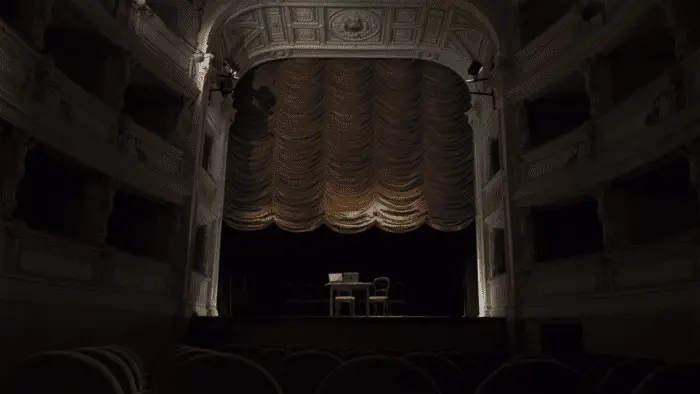Controversy is power of a very distinct kind. Jeremy O. Harris’s Slave Play demonstrates the potency of pure, uninhibited confrontation, a currency that has never quite been more valuable than in the tangible, breathable, in-person catharsis of theatre. Among the many fundamental separations between film and theatre is that removing the barrier of a screen is what creates dire urgency, engagement, and unparalleled discomfort for plays designed to unsettle an audience. But theatre is often ephemeral, even with the infinite range of interpretations it permits, and film works as a distinct, definitive piece of documentation. That knowledge of these two crucial distinguishing factors is the main means through which Harris steers his documentary Slave Play. Not a Movie. A Play. Any play that demands intense denial of self-aggrandizement from its audience is one that demands the same of its creators, and this documentary serves as a powerful statement of what that discomfort entails when it comes to tackling the intersections of race, sex, and power head-on.
Those three ideas are what Slave Play, in its original text, drives up to their absolute logical extremes with taboo-shattering confidence. Many viewers of this documentary are bound to not exactly be familiar with the context of the play itself, so to start, a short recap of its contents. Three interracial couples undergo what is referred to as Antebellum Sexual Performance Therapy, which amounts to exactly what it says on the tin; the act of sexually role playing slaves, slaveowners, and indentured servants as a means of getting Black partners to feel sexual pleasure again with their white partners.
The play is split into three acts. The first presents the therapy itself in action without any knowledge offered that it is therapy, with only nods present such as the playing of modern-day songs like Rihanna’s “Work” or Unknown Mortal Orchestra’s “Multi-Love,” or instances where the characters’ Southern accents get dropped as they—by which I mean predominantly, and almost always, the white characters—express discomfort with the uttering of specific epithets, racial degradations, and so on. The rupture then comes when the organizers of this therapy, themselves a lesbian interracial couple, intervene and invite the couples for a group therapy session. From there, the second act, and nearly the entire rest of the play, then ensues—a fiery examination of why this therapy exists, what its methods are based on, and what it ultimately implies for every one of its participants.
The bold-faced, Hail-Mary-aplomb depictions of explicit sexuality on-stage, the fetishization of the harrowing power imbalances inherent to slavery, and the subtleties of how modern racism takes on insidiously multifaceted forms even past slavery’s abolition, were the primary source of controversy this play stirred up in the years that followed. But Harris elects to get the controversy out of the way first by starting up his film with an edit of news outlets and commentators dishing out their own takes on the play’s contents, regardless of context. Preceding it, also, is a confrontation that took place in a post-show talkback in 2019 between Harris and a white woman in the audience who believed herself to have been ostensibly aggressed by the play’s contents and viewpoints. It’s a remarkably efficient piece of editing, a startling way to draw the audience into the maelstrom of discourse that surrounded the play, and above all else, a demonstration that it’s the aspect of the play that Harris is the least interested in fully exploring.

The Not a Movie. facet of the film’s title comes in the fact that the film almost deliberately pokes at the concept of adaptation. The documentary is structured around the play’s three acts, and much of the documentary’s contents are rehearsals for multiple scenes within the show, with multiple casts gathered in 2022 for a workshop process dedicated to being filmed and documented. Scattered moments from each act are portrayed to us, during which Harris directs the actors a certain way per scene, then runs different takes of their performances and line deliveries simultaneously in the edit. All the while, stage directions from the play’s text are superimposed, and moments where those scenes and lines were fully performed on a stage for an audience are cut into these rehearsals to demonstrate to the audience what it looks like for moments like these to be fully fleshed out on a stage. This may not be a documentary charting the process of how off-Broadway and Broadway productions of the play made it to the stage, and Harris admits that to be something he never truly considered during those processes. But the methodical way through which Harris and editors Pete Ohs and Teki Cruickshank navigate these timelines make it abundantly clear that this documentary still strives to be an insightful look into a strictly theatrical development process.
The rehearsals themselves prove to be the most thought-provoking part of the experience of the documentary, as most of its remainder is focused on Harris himself as he moves through this rehearsal process and reflects on what the experience of creating the play was like for him. Of course, there’s insight to be found in the ways Harris talks his way through the research that went into themes and ideas present in the play, the distinctions he observes between film and theatre as mediums, and the direction he offers up to the actors as the writer himself. (The lattermost is definitely unique to see in a theatrical industry where, unlike that of the cinematic auteur, it’s often rare to see examples of playwrights also directing their own work.) But there’s also a slight degree of solipsism present in just how much Harris indulges in letting himself take so much of the spotlight, particularly when it comes to a medium where artistic collaboration for new work development is prioritized more highly than in standard industry environments. What of the directors who took on this material in the past, such as Robert O’Hara? What of the personal perspectives that the actors for each character during the 2022 workshops must have brought to the table?
It’s worth noting that, yes, credits for the most prominent productions of Slave Play are presented early on in the film, and he briefly brings on the actors of the play’s first production at the Yale School of Drama and earlier Broadway productions for a series of interviews. Yet they hardly make much of an outsized impact on the documentary’s narrative itself relative to the multitude of scenes where we hear Harris speak on the nature of the play and its intentions. Certainly, his perspective as the literal playwright of the work is vital, but there’s a level of potentially intriguing objectivity of perspective often inherent to the act of direction and interpretation that gets lost in having Harris be the sole arbiter of presenting the narrative of his creation.
Credit where credit is due, however—it takes a mind of great boldness to even come up with a narrative like Slave Play, and to then come up with a cinematic response to an industry that must have at some point demanded that it be adapted to the screen even despite its double-entendre title’s incompatibility. Often, where Slave Play. Not a Movie. A Play. thrives is in the moments where we get to see the actors themselves get the chance to genuinely confront the significant challenge that the text of Harris’s play present to them. It’s a testament to the fact that Harris has been able to create a play on these subjects in a way that is productively confrontational, where audiences who embrace that confrontation in full may be edified by such a disquieting experience. And it’s also a display on the actors’ abilities to show that they’re able to take on the challenge of conveying that message—one that, once delivered right, is able to leave an outsized impact and discourse that lasts for years once it’s over. Fostering the furor of such discourse is likely the right impact to have for a play that seeks to tears open societal, racial, and sexual taboos built upon four hundred years of brutality, violence, repression, and oppression. To that end, Slave Play will likely remain a resounding, indisputable success, even if it may be an imperfect product, and that’s an achievement certainly worth celebrating in cinematic fashion.



